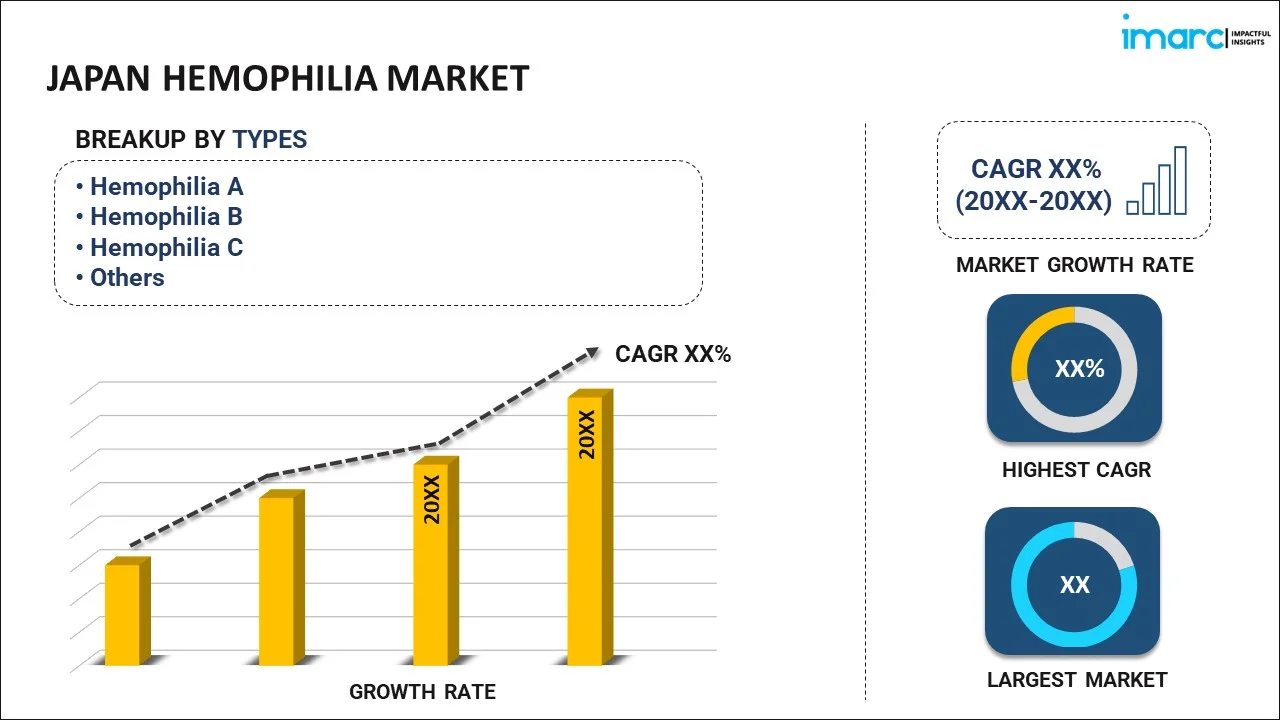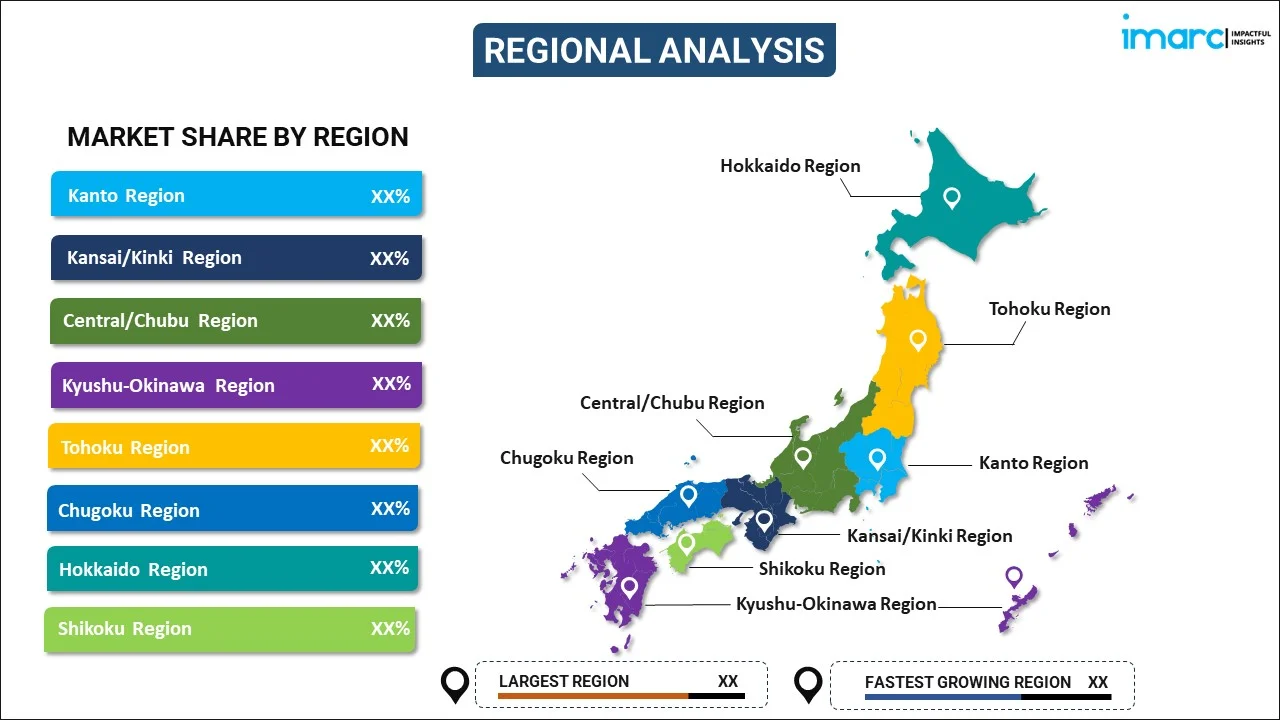
Japan Hemophilia Market Report by Type (Hemophilia A, Hemophilia B, Hemophilia C, and Others), Treatment (On-Demand, Prophylaxis), Therapy (Replacement Therapy, ITI Therapy, Gene Therapy), and Region 2025-2033
Market Overview:
The Japan hemophilia market size reached USD 846.0 Million in 2024. Looking forward, IMARC Group expects the market to reach USD 1,589.0 Million by 2033, exhibiting a growth rate (CAGR) of 7.3% during 2025-2033. The robust healthcare infrastructure in Japan, increasing focus on early diagnosis and effective management, rising research and development (R&D) activities, rapid advancements in hemophilia care, and the growing corporate partnerships between pharmaceutical companies and tech firms represent some of the key factors driving the market.
|
Report Attribute
|
Key Statistics
|
|---|---|
|
Base Year
|
2024
|
|
Forecast Years
|
2025-2033
|
|
Historical Years
|
2019-2024
|
|
Market Size in 2024
|
USD 846.0 Million |
|
Market Forecast in 2033
|
USD 1,589.0 Million |
| Market Growth Rate 2025-2033 | 7.3% |
Hemophilia refers to a rare genetic disorder characterized by the inability of the blood to clot properly, leading to prolonged bleeding. It is caused by the deficiency or absence of specific clotting proteins, such as Factor VIII or Factor IX, in the blood. It primarily occurs in two forms, such as Hemophilia A and Hemophilia B, distinguished by the specific clotting factor that is either reduced or missing. Hemophilia exhibits various symptoms such as frequent nosebleeds, easy bruising, joint pain, and severe bleeding from minor injuries. It is diagnosed through physical examination, medical history evaluation, genetic testing, inhibitor testing, and various laboratory tests, such as clotting factor assays. Hemophilia is treated using multiple methods, such as replacement therapy, prophylactic treatment, gene therapy, clot-promoting medications, pain management strategies, and supportive care. They aid in preventing bleeding episodes, improving quality of life, reducing pain, and minimizing joint damage.
Japan Hemophilia Market Trends:
The robust healthcare infrastructure in Japan, facilitating easier access to diagnostics and treatment for hemophilia patients, is one of the major factors contributing to the market growth. Moreover, the increasing focus on early diagnosis and effective management of the condition due to the high standard of healthcare services in the country is positively impacting the market growth. Additionally, the rising research and development (R&D) activities, backed by public and private investments, are providing a thrust to the market growth. In line with this, rapid advancements in hemophilia care, such as the development of extended half-life clotting factors and exploration of gene therapy options, are creating a positive outlook for the market growth. Furthermore, the increasing life expectancy of the population in Japan, requiring the need for long-term management of chronic conditions like hemophilia, is providing a thrust to the market growth. In addition to this, the implementation of various government grants and incentives for research projects focused on rare diseases is acting as a growth-inducing factor. Along with this, rapid advancements such as telemedicine, which make it easier for patients to consult with specialists, especially for those living in remote areas, are boosting the market growth. Besides this, the increasing prevalence of wearable technologies for health monitoring that are customized to monitor specific variables related to hemophilia is catalyzing the market growth. Apart from this, the widespread adoption of international treatment guidelines and protocols in Japan that help standardize care and make treatment more predictable and effective is bolstering the market growth. In line with this, the growing government aid in insurance approvals for certain kinds of treatments and medications that were earlier difficult to access is fostering the market growth.
Japan Hemophilia Market Segmentation:
IMARC Group provides an analysis of the key trends in each segment of the market, along with forecasts at the country level for 2025-2033. Our report has categorized the market based on type, treatment, and therapy.
Type Insights:

- Hemophilia A
- Hemophilia B
- Hemophilia C
- Others
The report has provided a detailed breakup and analysis of the market based on the type. This hemophilia a, hemophilia b, hemophilia c, and others.
Treatment Insights:
- On-Demand
- Prophylaxis
A detailed breakup and analysis of the market based on the treatment have also been provided in the report. This includes on-demand and prophylaxis.
Therapy Insights:
- Replacement Therapy
- ITI Therapy
- Gene Therapy
The report has provided a detailed breakup and analysis of the market based on the therapy. This includes replacement therapy, ITI therapy, and gene therapy.
Regional Insights:

- Kanto Region
- Kansai/Kinki Region
- Central/ Chubu Region
- Kyushu-Okinawa Region
- Tohoku Region
- Chugoku Region
- Hokkaido Region
- Shikoku Region
The report has also provided a comprehensive analysis of all the major regional markets, which include Kanto Region, Kansai/Kinki Region, Central/ Chubu Region, Kyushu-Okinawa Region, Tohoku Region, Chugoku Region, Hokkaido Region, and Shikoku Region.
Competitive Landscape:
The market research report has also provided a comprehensive analysis of the competitive landscape. Competitive analysis such as market structure, key player positioning, top winning strategies, competitive dashboard, and company evaluation quadrant has been covered in the report. Also, detailed profiles of all major companies have been provided.
Japan Hemophilia Market Report Coverage:
| Report Features | Details |
|---|---|
| Base Year of the Analysis | 2024 |
| Historical Period | 2019-2024 |
| Forecast Period | 2025-2033 |
| Units | Million USD |
| Scope of the Report | Exploration of Historical and Forecast Trends, Industry Catalysts and Challenges, Segment-Wise Historical and Predictive Market Assessment:
|
| Types Covered | Hemophilia A, Hemophilia B, Hemophilia C, Others |
| Treatments Covered | On-Demand, Prophylaxis |
| Therapies Covered | Replacement Therapy, ITI Therapy, Gene Therapy |
| Regions Covered | Kanto Region, Kansai/Kinki Region, Central/ Chubu Region, Kyushu-Okinawa Region, Tohoku Region, Chugoku Region, Hokkaido Region, Shikoku Region |
| Customization Scope | 10% Free Customization |
| Post-Sale Analyst Support | 10-12 Weeks |
| Delivery Format | PDF and Excel through Email (We can also provide the editable version of the report in PPT/Word format on special request) |
Key Questions Answered in This Report:
- How has the Japan hemophilia market performed so far and how will it perform in the coming years?
- What has been the impact of COVID-19 on the Japan hemophilia market?
- What is the breakup of the Japan hemophilia market on the basis of type?
- What is the breakup of the Japan hemophilia market on the basis of treatment?
- What is the breakup of the Japan hemophilia market on the basis of therapy?
- What are the various stages in the value chain of the Japan hemophilia market?
- What are the key driving factors and challenges in the Japan hemophilia?
- What is the structure of the Japan hemophilia market and who are the key players?
- What is the degree of competition in the Japan hemophilia market?
Key Benefits for Stakeholders:
- IMARC’s industry report offers a comprehensive quantitative analysis of various market segments, historical and current market trends, market forecasts, and dynamics of the Japan hemophilia market from 2019-2033.
- The research report provides the latest information on the market drivers, challenges, and opportunities in the Japan hemophilia market.
- Porter's five forces analysis assist stakeholders in assessing the impact of new entrants, competitive rivalry, supplier power, buyer power, and the threat of substitution. It helps stakeholders to analyze the level of competition within the Japan hemophilia industry and its attractiveness.
- Competitive landscape allows stakeholders to understand their competitive environment and provides an insight into the current positions of key players in the market.
Need more help?
- Speak to our experienced analysts for insights on the current market scenarios.
- Include additional segments and countries to customize the report as per your requirement.
- Gain an unparalleled competitive advantage in your domain by understanding how to utilize the report and positively impacting your operations and revenue.
- For further assistance, please connect with our analysts.
 Inquire Before Buying
Inquire Before Buying
 Speak to an Analyst
Speak to an Analyst
 Request Brochure
Request Brochure
 Request Customization
Request Customization




.webp)




.webp)












